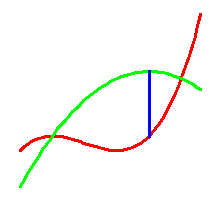| Multi-variable integration: the best thing since sliced bread |
This section is a brief reminder of the principle involved in computing multi-dimensional integrals.
In first-year calculus, you solved integration problems like the following.
Find the area of the region in the first quadrant where the curve y = -2x2 + 10x -3 lies above the curve y = 2x3 -9x2 + 12x.
 To do this, you would equate
the heights of the curves to find that they intersect when x
= 1 and when x = 3. Then you would regard the region
between the curves as the union of a large number of narrow
vertical rectangles with width equal to dx and with
height equal to the difference of the heights of the curves.
The sum of the areas of the thin rectangles is approximately
the area between the curves, and since the integral is the
limit of such Riemann sums,
you would find the exact area to be
20/3 by integrating (-2x2 + 10x -3) - (2x3 -9x2 +
12x) from x = 1 to x = 3.
To do this, you would equate
the heights of the curves to find that they intersect when x
= 1 and when x = 3. Then you would regard the region
between the curves as the union of a large number of narrow
vertical rectangles with width equal to dx and with
height equal to the difference of the heights of the curves.
The sum of the areas of the thin rectangles is approximately
the area between the curves, and since the integral is the
limit of such Riemann sums,
you would find the exact area to be
20/3 by integrating (-2x2 + 10x -3) - (2x3 -9x2 +
12x) from x = 1 to x = 3.
Volumes can be computed by a similar principle. To compute the volume of a loaf of bread, you slice the loaf into thin slices and add their volumes. The volume of a slice is its thickness times the area of its face, and so you get the volume of the loaf by integrating the area of a slice.
For example, to compute the volume of the unit ball (the set in three-dimensional space where x2 + y2 + z2 is less than 1), you might consider slicing the ball at height z. Such a slice is a circle whose radius is the square-root of (1-z2), so you can get the volume of the ball by integrating the area pi(1-z2) from the bottom of the ball (where z=-1) to the top of the ball (where z=1). You should get the usual result 4 pi/3.
A typical volume computation is somewhat harder than this, but only because the slices are not necessarily objects whose areas you know out of your head. In general, you have to do an auxiliary integration to compute the area of a slice at a variable height z. In complicated volume problems, you may need to break the object into pieces to facilitate the determination of the area of a slice.
Aside on the Busemann-Petty problem. The bread-slicing principle is the basis of Cavalieri's principle, which says that if all slices of one loaf by parallel planes have the same areas as the corresponding slices of another loaf, then the two loaves have the same volume. This principle is less obvious than it may appear.
Indeed, it seems equally obvious that if every slice of one melon by a plane passing through the origin has smaller area than the corresponding slice of a second melon, then the first melon must have smaller volume than the second. Actually, this turns out to be false for badly warped melons, but it is a sensible conjecture for melons that are convex and symmetric with respect to the origin. H. Busemann and C. M. Petty were unable to prove this spherical coordinate version of Cavalieri's principle, and they posed it as a problem in 1956. It was not until 1994 that R. J. Gardner obtained the affirmative answer in three-dimensional Euclidean space.
What about the analogous problem in Euclidean spaces of other dimensions? The surprising solution was completed in 1997. It turns out that the melon-slicing problem has a positive answer in dimensions 2, 3, and 4, but a negative answer in every higher dimension. Thus, there exist two convex, centrally symmetric five-dimensional melons with the property that every four-dimensional slice through the origin of the first melon has smaller area than the corresponding slice of the second melon, yet the first melon has larger volume than the second melon.
(For references, see R. J. Gardner, A. Koldobsky, and T. Schlumprecht, An analytic solution to the Busemann-Petty problem on sections of convex bodies, Ann. of Math. (2) 149 (1999), no. 2, 691-703; and the review in Mathematical Reviews 2001b:52011.)
The principle that the integral adds up lots of little bits can be used to compute a variety of geometric quantities. For example, a little bit of arc length of a curve in the xy-plane is ds, which by the Pythagorean theorem equals the square root of dx2 + dy2. So to find the length of a curve, you integrate dx times the square root of 1 + (dy/dx)2.
 The Math 696 course
pages were last modified April 5, 2005.
The Math 696 course
pages were last modified April 5, 2005.| Multi-variable integration: the best thing since sliced bread |